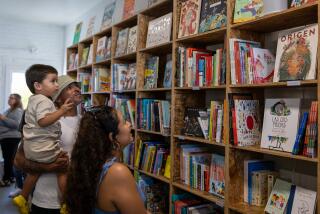Bookstores Take Page From Libraries’ Repertoire
- Share via
It’s 7 p.m., and the periodicals section is crowded with people thumbing through magazines and scanning Sunday newspapers from across the country.
At desks among the rows of book shelves, teenagers sit quietly, some solving algebra problems, others reading comic books.
Upstairs in the cheerfully decorated children’s book section, a group of youngsters gathers for the weekly “pajama-rama” story hour.
A typical evening at the library? No, this is the mammoth Barnes & Noble bookseller in Huntington Beach, a 43,000-square-foot store that fills a former furniture store building.
“It’s a fun place to hang out,” said Raymond Vu, a Huntington Beach computer consultant, as he sipped a cup of decaf. “I spend hours reading books and drinking coffee. . . . You don’t have to buy anything.”
*
As public libraries struggle to cope with budget cuts and reduced operating hours, giant bookstores such as Barnes & Noble and Borders Books and Music are picking up some of the slack by offering literary environments.
Their “mega-stores” are designed with comfort in mind, from easy chairs and sofas for relaxed reading to coffee bars serving freshly brewed espresso and cafe latte.
The retailers also host children’s reading programs and author lectures that many libraries have curtailed because of budget cuts.
Nonetheless, library officials are quick to point out that the primary goal of the bookstores is to sell products.
“The key distinction is that they are in it for a profit. They have to stock titles that will sell,” said Ron Hayden, director of Huntington Beach’s library system. “We provide a balance of information for the public. We are a warehouse for the storage of information.”
He and others see potential for booksellers and libraries to be partners, rather than competitors, in a growing market.
“Despite the conventional wisdom, people are reading more,” said County Librarian John M. Adams, noting that local library circulation is up.
The number of items checked out through the county library system was 6.4 million last year, he said, up from 6.1 million the year before.
Booksellers’ commercial pressures limit them to some extent. To make money, the stores must stock titles that sell. Libraries, by contrast, can offer a broader assortment of books, some of which may be checked out a few times a year.
“I don’t want to spend $200 or $300 for landscaping books if I’m going to use them once,” Hayden said. “That’s what a library is for.”
Libraries also provide crucial services to students, job-seekers and others who need books and periodicals but cannot afford to purchase them.
What retailers and librarians say they would like to achieve is a synergy.
That is already happening in some cities. A Barnes & Noble fund-raiser for a Huntington Beach middle school, for example, resulted in the donation of hundreds of books to the campus library.
The Borders in Mission Viejo has held fund-raisers for the city’s library and sometimes refers customers there when it cannot supply books.
A poetry group and women’s book club use the store to hold their meetings because the local library is too small.
“It really does fill a void,” Mission Viejo Mayor Sherri M. Butterfield said. “It’s wonderful to have a facility that can do part of what we need to do to serve the community.”
The bookstores employ community specialists who organize store events such as Black History Month programs and lectures featuring well-known authors such as Native American activist Russell Means, mystery writer Elizabeth George and comedian Steve Allen.
“We see this as a service for the public,” said James Arnold, community relations coordinator for the Borders in Mission Viejo. “People are free to come all day and read all the books they want. We hope the store will win them over, and they will come back.”
*
The stores’ growing popularity is also an example of how easily they fit into the daily routines of customers such as Jean Hartman, who brings her daughter to the Barnes & Noble storytelling program every few weeks.
“It’s convenient to pop in,” said Hartman, of Westminster. “The Broadway is next door. The supermarket is down the street. We run in here while we are shopping.”
Many library branches, on the other hand, are near parks and civic centers but away from retail districts.
Moreover, some county libraries--including the one near the Hartmans’ home--have reduced evening hours recently.
Despite tight finances, librarians said they are also striving to serve their patrons better. The county library system is even borrowing a page from the mega-stores: The new Aliso Viejo branch will include a snack bar selling sandwiches, drinks and candy.
Barnes & Noble patron Vu heartily endorses that idea. “Coffee and books just go together,” he said.
(BEGIN TEXT OF INFOBOX / INFOGRAPHIC)
Making Customers Comfortable
“Mega” bookstores such as Barnes & Noble and Borders Books & Music have incorporated many library-like touches designed to foster customer loyalty and keep people in the stores longer. Some of the services offered:
* Chairs, desks and sofas that allow customers to sit down and read
* Large selections of out-of-town newspapers as well as obscure periodicals
* Elaborately decorated children’s sections that offer storytelling programs
* Meeting space for local reading clubs and poetry groups
* Fund-raising events and programs for schools and public libraries
* Author lectures and book-signings
Source: Times reports; Researched by SHELBY GRAD / For The Times
Los Angeles Times
More to Read
Sign up for our Book Club newsletter
Get the latest news, events and more from the Los Angeles Times Book Club, and help us get L.A. reading and talking.
You may occasionally receive promotional content from the Los Angeles Times.











